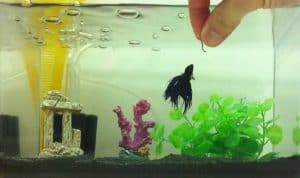
Live foods are the best diet for your Betta fish because they provide essential bacteria that are vital to the immune system. Even the pickiest fish cannot resist live foods. It is best to make your own live food because purchasing it from a pet store is risky since you risk transferring diseases from one fish to another. Live food preparation is time-consuming and messy, but it is rewarding for the fish.
Adding live food to a betta’s diet
Adding live food to a betty’s diet can be a great way to supplement their diet and help them fight disease. However, it’s important to note that live food can also carry diseases. Some types of live food may have tuberculosis, which is deadly to bettas.
Live food like daphnia is rich in protein and fiber. It can help your fish’s digestive system work properly. Daphnia eats plant life, which is why it contains fibrous matter. This material helps your fish digest food and will prevent constipation.
When adding live food to a betta fish’s diet, you must be sure to follow the guidelines provided by the manufacturer. It’s important to remember that bettas have short digestive tracts and are easily overfed. Therefore, it’s crucial to only feed small portions of live food. This will prevent constipation and bloating, which can be dangerous for your betta’s health.
Adding micro worms is another option for live food for bettas. While micro worms contain a lot of fat, they are good for a betta’s diet. They also provide a rich source of protein for fry and juvenile bettas. In addition, moina, the smallest version of daphnia, are a good choice for juvenile bettas. Moina are also good for bettas with fussy stomachs.
Mosquito larvae are another excellent live food option for bettas. These are easily available in many bodies of water. However, these species may be hard to obtain in colder climates. Adding mosquito larvae to a betta fish feeder can help keep his digestive system moving and give him an essential nutritional boost.
Adding frozen food to a betta’s diet
Adding frozen food to a betto’s diet is an excellent way to provide protein and balance the diet. Bettas have a high demand for protein and need a balanced diet to thrive. The best sources for protein are flakes and pellets.
Frozen food is easily available at local aquarium stores. You can also order frozen food from online stores. If you order frozen food online, you should keep in mind that it may defrost during shipment. It’s not difficult to add frozen food to your betta’s diet.
Frozen foods are great for Bettas because they mimic their natural diet. Bettas love to eat from the surface, so you should add a variety of frozen food to their feeder. A good selection of frozen foods includes mosquito larvae, bloodworms, Mysis shrimp, and brine shrimp.
Adding live foods to a betta’s diet will also provide a variety of nutrients. Because they are carnivorous, bettas should eat a variety of meat-based foods. You can also use freeze-dried or frozen food as a supplement. A variety of foods is the best way to keep your betta healthy.
While some bettas will happily eat more than the recommended amount, 1.8 grams a day is a good goal. It’s also important to remember that a betta’s diet needs to be well balanced to maintain its health. If your betta fish refuses to eat, it could be due to illness or stress, so it’s best to vary the feeding schedule.
Adding a programmable betta fish feeder
An automated fish feeder is a convenient addition to your Betta’s tank. These feeders can dispense dry, frozen, or live food. Bettas eat mostly meat, but you can also add some plant matter to the diet. They’re best fed a diet that contains a high amount of protein. Tropical flakes don’t provide the right nutritional balance, but automated fish feeders can make feeding them a breeze.
Some automatic fish feeders are programmable, so you can set the exact time and amount of food for your fish. This feature can save you from feeding your fish by hand or when you’re away. These feeders are easy to install and operate. You can choose from various options and find the one that suits your needs the best.
If you’re having trouble feeding your betta at the same time every day, you can try live food. Bettas do well with worms, shrimp, and small fish. However, it’s not recommended for long periods of time. It’s best to use a feeding device that doesn’t need frequent water changes. Food blocks are also an option if you don’t want to feed your betta fish live food. There are many different kinds of food blocks you can purchase, and some of them are even specially made for betta tanks.
Programmable betta fish feeders allow you to set the timing of each feeding. You can choose the time and amount of each feeding, so you don’t have to worry about overfeeding your betta.


